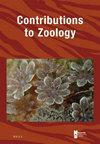古鳗的卵生、胎生或繁殖模式的可塑性:由猎物反刍引起的史诗般的误解?
IF 2.2
2区 生物学
Q1 ZOOLOGY
引用次数: 2
摘要
洞穴动物是过渡到极端地下环境引起的快速进化变化的生物学模型。但他们隐蔽的生活方式使得研究生活史的变化本身就很困难。因此,目前对洞穴物种的繁殖知之甚少,对一般模式和潜在的共同繁殖策略的了解就更少了。理论预测,洞穴环境有利于少数发育良好的后代和活产。对于最神秘的洞穴动物之一——洞螈(Proteus anguinus)来说,它们是通过活产(胎生)、产卵(卵生)还是兼性繁殖一直存在激烈的争论。虽然在20世纪50年代之后圈养繁殖的成功报告了卵子是单胎模式,但一些历史上较早的观察声称是活胎模式。备受争议的新拉马克主义者保罗·卡默勒(Paul Kammerer)甚至声称,通过改变环境条件,已经引起了宇称模式的变化。本文报道了水蛭对火蝾螈(Salamandra Salamandra)幼虫的摄食和反刍过程。这些蝾螈幼虫的头部有明显的牙印和其他由洞虫造成的伤害,但有一只幼虫在反刍后仍然活着。我们认为历史上关于olm生长期的报道可能被反刍的蝾螈幼虫误导了。我们的数据进一步表明,卡默勒的实验至少有一部分是伪造的。本文章由计算机程序翻译,如有差异,请以英文原文为准。
Oviparity, viviparity or plasticity in reproductive mode of the olm Proteus anguinus: an epic misunderstanding caused by prey regurgitation?
Cave animals are biological models of fast evolutionary change induced by transition to extreme subterranean environments. But their concealed lifestyle makes it inherently difficult to study life-history changes. Therefore, currently very little is known on the reproduction of cave species, and even less is known on general patterns and potentially shared reproductive strategies. Theory predicts that the cave environment favours the production of a few well-developed offspring and live birth. For one of the most enigmatic cave animals, the olm (Proteus anguinus), it has been debated fiercely whether they reproduce by live birth (viviparity), egg-laying (oviparity) or facultatively. While successes in captive breeding after the 1950s report oviparity as the single parity mode, some historically older observations claimed viviparity. The controversial neo-Lamarckist Paul Kammerer even claimed to have induced changes in parity mode by altering environmental conditions. Here, we report on the feeding and regurgitation of fire salamander (Salamandra salamandra) larvae by olms. The salamander larvae showed clear teeth marks and other injuries on the head caused by the olm, yet one larva was still alive after regurgitation. We suggest that historical reports of olm viviparity could have been misled by regurgitated salamander larvae. Our data bring additional indications that at least some of Kammerer’s experiments were fraudulent.
求助全文
通过发布文献求助,成功后即可免费获取论文全文。
去求助
来源期刊

Contributions to Zoology
生物-动物学
CiteScore
4.00
自引率
4.50%
发文量
16
审稿时长
>12 weeks
期刊介绍:
Contributions to Zoology solicits high-quality papers in all systematics-related branches of comparative zoology (including paleozoology). Preference will be given to manuscripts dealing with conceptual issues and to integrative papers (e.g., ecology and biodiversity, morphology and phylogeny and character state evolution, phylogeny and historical biogeography, systematics and bioinformatics, bioinformatics and biodiversity, habitat disturbance and biogeography, etc.). Reviews and alpha-taxonomic contributions are considered for publication, but acceptance will depend on their high quality and exceptional nature.
 求助内容:
求助内容: 应助结果提醒方式:
应助结果提醒方式:


